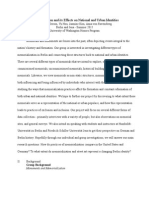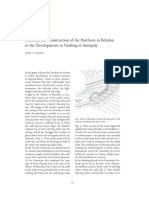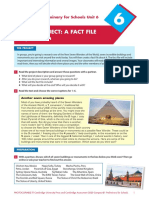0 ratings0% found this document useful (0 votes)
46 viewsMonument Essay
Monument Essay
Uploaded by
Lauren RosadoThis document discusses important factors to consider when creating memorials to honor people or events. It argues that memorials should be located where the individual had the most impact, such as where they lived or contributed their work, in order to properly commemorate them. The size of the memorial should also reflect the significance of the person or event. Additionally, the materials used in constructing the memorial should illustrate the importance and lasting impact of what is being memorialized. Overall, the key factors agencies must weigh are location, size, materials, and message when determining how best to memorialize and pay tribute through monuments.
Copyright:
© All Rights Reserved
Available Formats
Download as PDF, TXT or read online from Scribd
Monument Essay
Monument Essay
Uploaded by
Lauren Rosado0 ratings0% found this document useful (0 votes)
46 views2 pagesThis document discusses important factors to consider when creating memorials to honor people or events. It argues that memorials should be located where the individual had the most impact, such as where they lived or contributed their work, in order to properly commemorate them. The size of the memorial should also reflect the significance of the person or event. Additionally, the materials used in constructing the memorial should illustrate the importance and lasting impact of what is being memorialized. Overall, the key factors agencies must weigh are location, size, materials, and message when determining how best to memorialize and pay tribute through monuments.
Original Description:
AP LANG Monument Essay
Copyright
© © All Rights Reserved
Available Formats
PDF, TXT or read online from Scribd
Share this document
Did you find this document useful?
Is this content inappropriate?
This document discusses important factors to consider when creating memorials to honor people or events. It argues that memorials should be located where the individual had the most impact, such as where they lived or contributed their work, in order to properly commemorate them. The size of the memorial should also reflect the significance of the person or event. Additionally, the materials used in constructing the memorial should illustrate the importance and lasting impact of what is being memorialized. Overall, the key factors agencies must weigh are location, size, materials, and message when determining how best to memorialize and pay tribute through monuments.
Copyright:
© All Rights Reserved
Available Formats
Download as PDF, TXT or read online from Scribd
Download as pdf or txt
0 ratings0% found this document useful (0 votes)
46 views2 pagesMonument Essay
Monument Essay
Uploaded by
Lauren RosadoThis document discusses important factors to consider when creating memorials to honor people or events. It argues that memorials should be located where the individual had the most impact, such as where they lived or contributed their work, in order to properly commemorate them. The size of the memorial should also reflect the significance of the person or event. Additionally, the materials used in constructing the memorial should illustrate the importance and lasting impact of what is being memorialized. Overall, the key factors agencies must weigh are location, size, materials, and message when determining how best to memorialize and pay tribute through monuments.
Copyright:
© All Rights Reserved
Available Formats
Download as PDF, TXT or read online from Scribd
Download as pdf or txt
You are on page 1of 2
Monument Essay
As a means of acknowledging a person's accomplishments or sacrifices,
memorializing them is a special moment. When doing something like this, there
are many things to consider. It is up to agencies to determine whether to
memorialize an event or a person, depending on the circumstances. To make a
truly fitting memorial, many different things must be considered. To create a
memorial worthy of its recipients, the agency must plan out the proper location,
size, and materials. Often, memorials honor people and events for achieving
great acclaim or paying homage to those who made untold sacrifices.
Many factors need to be taken into consideration when creating
memorials. Choosing the right location to create a memorial can make all the
difference. Regardless of where the event occurred, it should be memorialized
there. It should be remembered if someone made a major contribution to a
particular place. As stated in Source F, “H. Elroy Johnson made money trapping
lobsters and lived in Harpswell, Maine. In 1939 he posed for a sculpture titled
“The Maine Lobsterman,” kneeling before his favorite crustacean while pegging
its claw” (Source F). Johnson was responsible for the economy of Maine by
catching lobsters, so they built a statue of him near where he would catch
lobsters. This strengthens the argument that memorials should be erected in
places where the individual made a positive impact; memorials should be placed
in places that stand out and get people thinking about the person or event they
commemorate. As shown in Source B, “The following is a photo of a monument
of Christopher Columbus in Riverside Park, Easton, Pennsylvania.” (Source B)
The statue of Columbus is in a park that highlights the statue. He left an
indelible mark on the United States when people walk past his sculpture. People
wouldn't pay much attention to the statue, for example, if it were positioned in
the middle of a parking lot. This detracts from its value. The importance of a
person's location when memorializing an event or person is demonstrated here.
People generally agree that if the person or event is being remembered, it
can be displayed anywhere. There would be less impact for the event or person
to be remembered if this was done. As stated in Source E, “It is not surprising
that immediate and intense controversy erupted when plans were publicized to
build a Holocaust Museum on The Mall in Washington, D.C” (Source E). The
Holocaust did not take place in Washington, D.C., nor does it have anything to
do with it. There would be a controversy if this memorial were placed at a mall
of monuments, which would be incongruous. In order to pay homage to this
place of significance, I found the Holocaust memorial more appropriate where it
took place. The size of the memorial is also critical for the planning process. To
size a memorial appropriately, agencies need to consider the impact an
individual or event had. Rather than a smaller memorial for someone who didn't
have as much impact, a memorial for one who had a huge impact should be
erected in their honor. Materials used to construct a memorial are crucial, as
well. The materials should illustrate the importance of the person and the
impact they had.
Furthermore, agencies should think about the message they hope to
convey through memorials. In a perfect world, monuments should
commemorate the people or events in a way that makes them proud to be
remembered. Aside from the materials and the location, the audience should be
able to determine how and where they affected change. When creating
memorials, agencies must consider many factors. A tribute should also be paid
to people and events that have been momentous in their lives or have sacrificed
deeply. Creating an effective memorial requires agencies to consider the size,
location, and meaning of the monument they are planning.
You might also like
- Married To The Mouse PDFDocument284 pagesMarried To The Mouse PDFYogi100% (1)
- Rhetorical Analysis EssayDocument6 pagesRhetorical Analysis Essayapi-268209830100% (2)
- Kobena Mercer, Skin Head Sex ThingDocument25 pagesKobena Mercer, Skin Head Sex ThingClaudia Pretelin100% (1)
- Sophia HIST II Milestone 1Document11 pagesSophia HIST II Milestone 1silangelasp100% (1)
- Guide To Us Type CoinsDocument36 pagesGuide To Us Type CoinsJorge Luis PiñeiroNo ratings yet
- Module On Art History and Art Movements (Part 1)Document8 pagesModule On Art History and Art Movements (Part 1)Paul macaraegNo ratings yet
- Synthesis Docx 1Document3 pagesSynthesis Docx 1api-193320795No ratings yet
- Synthesis 1Document4 pagesSynthesis 1api-514796543No ratings yet
- On Memory, Tra 1250Document8 pagesOn Memory, Tra 1250plavaadresaNo ratings yet
- Revision 2 ChangesDocument3 pagesRevision 2 Changesapi-756239956No ratings yet
- Anti-Memorials and The Art of Forgetting - Critical Reflections On A Memorial Design PracticeDocument16 pagesAnti-Memorials and The Art of Forgetting - Critical Reflections On A Memorial Design PracticejajaNo ratings yet
- Synthesis Draft2Document2 pagesSynthesis Draft2api-270693818No ratings yet
- Essay #3Document11 pagesEssay #3Irene Murua TxintxurretaNo ratings yet
- Marisa's ThesisDocument62 pagesMarisa's ThesisLindsey MaeNo ratings yet
- SB REPORT 8 2 LowrezDocument36 pagesSB REPORT 8 2 LowrezShahiraNo ratings yet
- 07 On Memory, Trauma, Public Space, Monuments, and MemorialsDocument9 pages07 On Memory, Trauma, Public Space, Monuments, and MemorialsKurdistan SalamNo ratings yet
- Research Project Only NatDocument7 pagesResearch Project Only Natapi-241295378No ratings yet
- Recovering The PastDocument18 pagesRecovering The PastMilicaBožićMarojevićNo ratings yet
- Contested Terrain: History, Museums, and The Public: National Council On Public History President's Annual AddressDocument11 pagesContested Terrain: History, Museums, and The Public: National Council On Public History President's Annual Addresssilvana_seabraNo ratings yet
- Commemoration in America: Essays on Monuments, Memorialization, and MemoryFrom EverandCommemoration in America: Essays on Monuments, Memorialization, and MemoryNo ratings yet
- Public History: Its Origins, Nature, and Prospects Robert KelleyDocument6 pagesPublic History: Its Origins, Nature, and Prospects Robert KelleySilvio PedrosaNo ratings yet
- Sculpturedraft 2Document2 pagesSculpturedraft 2api-286450326No ratings yet
- Memorialization and Its Effects On National and Urban IdentitiesDocument17 pagesMemorialization and Its Effects On National and Urban Identitiesapi-272539641No ratings yet
- Dwyer 2000 PGDocument13 pagesDwyer 2000 PGAbdoukadirr SambouNo ratings yet
- FJM - Personal StatementDocument1 pageFJM - Personal StatementmcewenNo ratings yet
- GoldsteinannotatedbibDocument3 pagesGoldsteinannotatedbibapi-342072244No ratings yet
- Updated Monuments and Memorials HSDocument13 pagesUpdated Monuments and Memorials HSsarah smithNo ratings yet
- Civil Rights Memorials and The Geography of MemoryDocument4 pagesCivil Rights Memorials and The Geography of MemoryASHRAFNo ratings yet
- How To Write A Community Service EssayDocument8 pagesHow To Write A Community Service Essayhwwhienbf100% (2)
- The Right OneDocument7 pagesThe Right OneRobert Summers-BergerNo ratings yet
- Seeing the Better City: How to Explore, Observe, and Improve Urban SpaceFrom EverandSeeing the Better City: How to Explore, Observe, and Improve Urban SpaceRating: 5 out of 5 stars5/5 (1)
- The Historian's Eye: Photography, History, and the American PresentFrom EverandThe Historian's Eye: Photography, History, and the American PresentNo ratings yet
- The Location of Culture The Urban Cultur PDFDocument25 pagesThe Location of Culture The Urban Cultur PDFGeorge ValentinNo ratings yet
- Space and Society: Dr. Zujaja Wahaj Topic: Imagining Space: The Key ConceptsDocument17 pagesSpace and Society: Dr. Zujaja Wahaj Topic: Imagining Space: The Key ConceptsGulshaRaufNo ratings yet
- Research Essay FinalDocument11 pagesResearch Essay Finalapi-519040761No ratings yet
- Albert Einstein EssayDocument8 pagesAlbert Einstein Essaydunqfacaf100% (1)
- Luke Allen Rhetorical Analysis 1.2 - First SubmissionDocument7 pagesLuke Allen Rhetorical Analysis 1.2 - First Submissionlaxluke17No ratings yet
- Reading Response 9 ActualDocument5 pagesReading Response 9 Actualliamg453No ratings yet
- Pulic Memory and Private GriefDocument21 pagesPulic Memory and Private GriefHoa NguyenNo ratings yet
- 7787-Article Text-36005-2-10-20210701-1Document12 pages7787-Article Text-36005-2-10-20210701-1João ManuelNo ratings yet
- Essay On Growth of PopulationDocument6 pagesEssay On Growth of Populationdnrlbgnbf100% (2)
- Bearing Witness: The Wounds of Mass Trauma at Memorial MuseumsFrom EverandBearing Witness: The Wounds of Mass Trauma at Memorial MuseumsNo ratings yet
- Social Sculpture J Barnum 2010Document5 pagesSocial Sculpture J Barnum 2010jeffbarnumNo ratings yet
- Opting for Elsewhere: Lifestyle Migration in the American Middle ClassFrom EverandOpting for Elsewhere: Lifestyle Migration in the American Middle ClassNo ratings yet
- Opting for Elsewhere: Lifestyle Migration in the American Middle ClassFrom EverandOpting for Elsewhere: Lifestyle Migration in the American Middle ClassNo ratings yet
- Germany Research Proposal DraftDocument8 pagesGermany Research Proposal Draftapi-287769499No ratings yet
- Germany Research Proposal DraftDocument8 pagesGermany Research Proposal Draftapi-287769499100% (1)
- Berliner. The Boom of MemoryDocument15 pagesBerliner. The Boom of MemoryAna G Ballate BenavidesNo ratings yet
- Anti Death Penalty Arguments EssayDocument4 pagesAnti Death Penalty Arguments Essaynpvvuzbaf100% (2)
- Georgia Guide Stones & NWODocument16 pagesGeorgia Guide Stones & NWOjofortruth50% (2)
- Discovering Richmond Monuments: A History of River City Landmarks Beyond the AvenueFrom EverandDiscovering Richmond Monuments: A History of River City Landmarks Beyond the AvenueRating: 5 out of 5 stars5/5 (1)
- The Creation of Transnational Memory Spaces: Professionalization and CommercializationDocument19 pagesThe Creation of Transnational Memory Spaces: Professionalization and CommercializationMaría GarcíaNo ratings yet
- (IID2013) Midterm Papers by Pho Vu (Hemin)Document6 pages(IID2013) Midterm Papers by Pho Vu (Hemin)Pho VuNo ratings yet
- Distant Publics: Will Kurlinkus University of OklahomaDocument18 pagesDistant Publics: Will Kurlinkus University of OklahomaWill KurlinkusNo ratings yet
- A History Lover's Guide to Washington, D.C.: Designed for DemocracyFrom EverandA History Lover's Guide to Washington, D.C.: Designed for DemocracyRating: 4 out of 5 stars4/5 (1)
- Sen, Armatya - How Does Culture Matter PDFDocument30 pagesSen, Armatya - How Does Culture Matter PDFukguangdonglisaNo ratings yet
- Bank Robbery EssayDocument8 pagesBank Robbery Essayaaqvuknbf100% (2)
- Joining The Conversation: The Rhetorical Work of National Monuments The 9/11 Memorial and MuseumDocument8 pagesJoining The Conversation: The Rhetorical Work of National Monuments The 9/11 Memorial and Museumapi-340299236No ratings yet
- Global Memoryscapes: Contesting Remembrance in a Transnational AgeFrom EverandGlobal Memoryscapes: Contesting Remembrance in a Transnational AgeNo ratings yet
- DragonLock Mega Pack 05162023 ListDocument2 pagesDragonLock Mega Pack 05162023 ListJonathan Jasiel RamirezNo ratings yet
- Class 9th - WorksheetDocument2 pagesClass 9th - Worksheetdikshasrivastava9911No ratings yet
- Region 7Document18 pagesRegion 7Dareen CuetoNo ratings yet
- A7 VijayanagaraDocument50 pagesA7 VijayanagaraAbhay SharmaNo ratings yet
- Characteristics of Egyptian ArchitectureDocument3 pagesCharacteristics of Egyptian ArchitecturegalindopNo ratings yet
- Purnachandi Temple Lalitpur: Chobha ShresthaDocument6 pagesPurnachandi Temple Lalitpur: Chobha ShresthaRavi ShakyaNo ratings yet
- 1 Prehistoric ArchitectureDocument64 pages1 Prehistoric ArchitectureJano AgbigayNo ratings yet
- Reading 81Document4 pagesReading 81Naomi Elizabeht Cohaila AguilarNo ratings yet
- Neolithic ArchitectureDocument2 pagesNeolithic Architecturemaria.232500740% (1)
- Civilization TopicsDocument3 pagesCivilization TopicsVictoriaVacarițaNo ratings yet
- Mauryan Art and ArchitectureDocument13 pagesMauryan Art and ArchitectureAradhana Chang100% (1)
- Chapter 3 - Descriptive Text (Meeting 1)Document20 pagesChapter 3 - Descriptive Text (Meeting 1)9H17 makaylaNo ratings yet
- Old and Middle Kingdom Tradition in The Temple of Hatshepsut at Deir El-BahariDocument33 pagesOld and Middle Kingdom Tradition in The Temple of Hatshepsut at Deir El-BahariLaura PeñaNo ratings yet
- Sentinel Comics The Roleplaying Game Issue 345 - Tome of The Bizarre #86Document12 pagesSentinel Comics The Roleplaying Game Issue 345 - Tome of The Bizarre #86Robert Arndt100% (1)
- Apollo - Monumental Lies: Culture Wars and The Truth About The PastDocument1 pageApollo - Monumental Lies: Culture Wars and The Truth About The PastrpmbevanNo ratings yet
- PyramidsDocument10 pagesPyramidsapi-355163163No ratings yet
- Draw 50 Monuments ArchitectureDocument55 pagesDraw 50 Monuments Architecturejackoftrades100% (5)
- Case StudiesDocument84 pagesCase StudiesGaurav JainNo ratings yet
- 7 Wonders of The WorldDocument2 pages7 Wonders of The WorldmarianograssaNo ratings yet
- Unit2 Next 5 SlidesDocument5 pagesUnit2 Next 5 Slidesarchitectfemil6663No ratings yet
- French CultureDocument11 pagesFrench CultureUmedaliNo ratings yet
- Materials and Construction of The PantheDocument9 pagesMaterials and Construction of The Pantheybha484No ratings yet
- Compact Project 06 B1 Preliminary For SchoolsDocument7 pagesCompact Project 06 B1 Preliminary For SchoolsHelena HacheNo ratings yet
- Final Slides yDocument73 pagesFinal Slides ySiddhi MaharjanNo ratings yet
- Castel Nuovo and Castel Capurano W NeapoluDocument35 pagesCastel Nuovo and Castel Capurano W NeapoluLena KNo ratings yet
- Mughal Architecture: Presentation TopicDocument25 pagesMughal Architecture: Presentation TopicFA20-CHE-107 (ABDULMOEEZ ) UnknownNo ratings yet
- CAE Phoenix Handbook: Your Worldwide Training Partner of ChoiceDocument24 pagesCAE Phoenix Handbook: Your Worldwide Training Partner of ChoiceSilverberg GuitarsNo ratings yet
- Content2 LC6 Activity 1 Tangible and Intangible HeritageDocument8 pagesContent2 LC6 Activity 1 Tangible and Intangible HeritageJohn Adam MorataNo ratings yet

























































































